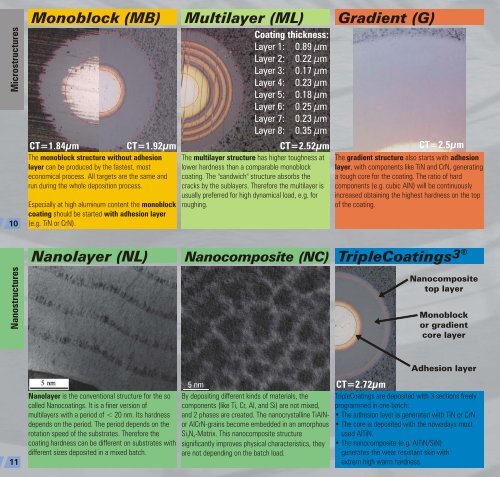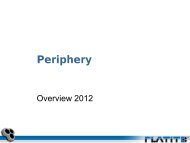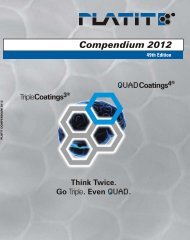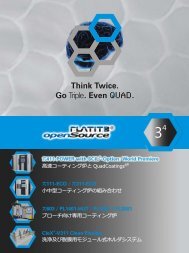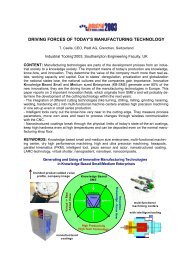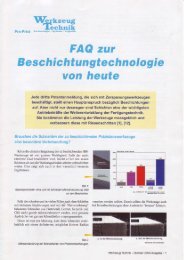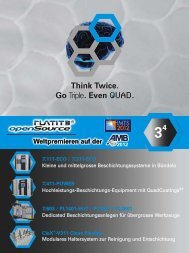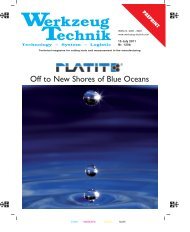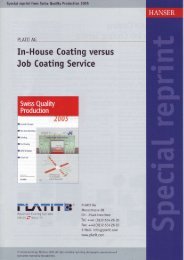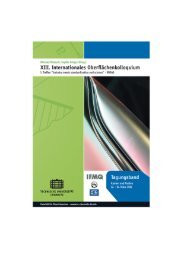You also want an ePaper? Increase the reach of your titles
YUMPU automatically turns print PDFs into web optimized ePapers that Google loves.
Microstructures<br />
10<br />
Monoblock (MB)<br />
The monoblock structure without adhesion<br />
layer can be produced by the fastest, most<br />
economical process. All targets are the same and<br />
run during the whole deposition process.<br />
Especially at high aluminum content the monoblock<br />
coating should be started with adhesion layer<br />
(e.g. TiN or CrN).<br />
Multilayer (ML)<br />
Coating thickness:<br />
Layer 1: 0.89 µm<br />
Layer 2: 0.22 µm<br />
Layer 3: 0.17 µm<br />
Layer 4: 0.23 µm<br />
Layer 5: 0.18 µm<br />
Layer 6: 0.25 µm<br />
Layer 7: 0.23 µm<br />
Layer 8: 0.35 µm<br />
CT=1.84µm CT=1.92µm CT=2.52µm<br />
The multilayer structure has higher toughness at<br />
lower hardness than a comparable monoblock<br />
coating. The "sandwich" structure absorbs the<br />
cracks by the sublayers. T<strong>here</strong>fore the multilayer is<br />
usually preferred for high dynamical load, e.g. for<br />
roughing.<br />
Gradient (G)<br />
CT=2.5µm<br />
The gradient structure also starts with adhesion<br />
layer, with components like TiN and CrN, generating<br />
a tough core for the coating. The ratio of hard<br />
components (e.g. cubic AlN) will be continuously<br />
increased obtaining the highest hardness on the top<br />
of the coating.<br />
Nanostructures<br />
Nanolayer (NL)<br />
Nanocomposite (NC)<br />
TripleCoatings 3®<br />
Nanocomposite<br />
top layer<br />
Monoblock<br />
or gradient<br />
core layer<br />
11<br />
Nanolayer is the conventional structure for the so<br />
called Nanocoatings. It is a finer version of<br />
multilayers with a period of < 20 nm. Its hardness<br />
depends on the period. The period depends on the<br />
rotation speed of the substrates. T<strong>here</strong>fore the<br />
coating hardness can be different on substrates with<br />
different sizes deposited in a mixed batch.<br />
5 nm<br />
By depositing different kinds of materials, the<br />
components (like Ti, Cr, Al, and Si) are not mixed,<br />
and 2 phases are created. The nanocrystalline TiAlNor<br />
AlCrN-grains become embedded in an amorphous<br />
Si3N4-Matrix. This nanocomposite structure<br />
significantly improves physical characteristics, they<br />
are not depending on the batch load.<br />
CT=2.72µm<br />
Adhesion layer<br />
TripleCoatings are deposited with 3 sections freely<br />
programmed in one batch:<br />
• The adhesion layer is generated with TiN or CrN.<br />
• The core is deposited with the nowadays most<br />
used AlTiN.<br />
• The nanocomposite (e.g. AlTiN/SiN)<br />
generates the wear resistant skin with<br />
extrem high warm hardness.


